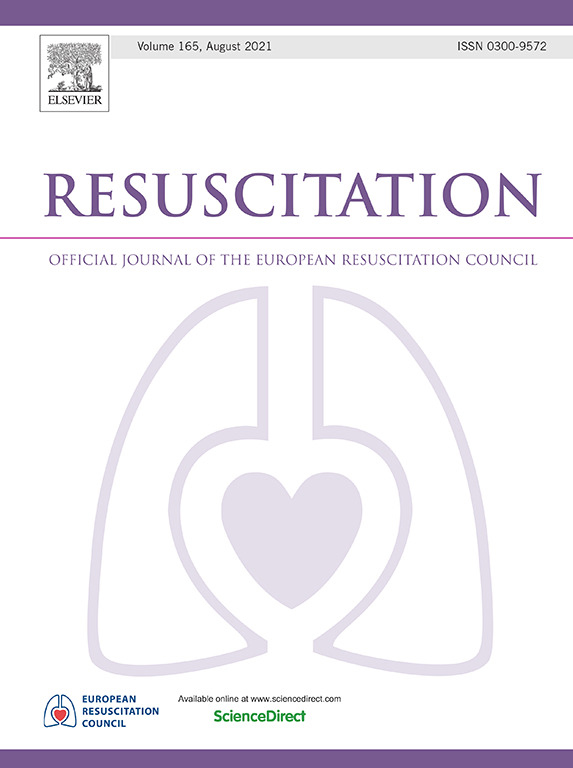心肺复苏期间不同通气策略对院外心脏骤停患者自发循环恢复的影响:来自德国复苏登记处的回顾性研究
IF 4.6
1区 医学
Q1 CRITICAL CARE MEDICINE
引用次数: 0
摘要
目的:评价不同停搏内通气策略与成年OHCA患者自主循环恢复(ROSC)、住院率和24小时生存率的关系。方法:这项回顾性横断面研究分析了来自德国复苏登记处的数据。2016年3月至2023年3月期间发生非外伤性院外心脏骤停(OHCA)的成年患者(≥18岁),如果他们在ROSC前接受过心肺复苏术、气管插管,并有记录的通气策略,则纳入研究。比较4种通气模式:间歇正压通气(IPPV)、胸压同步通气(CCSV)、双相气道正压通气(BIPAP)和手动气囊阀通气(手动)。根据心脏骤停后ROSC评分(RACA),比较观察ROSC (ROSCobs)与预期ROSC (ROSCexp)。次要结局是住院情况和24小时生存率。结果:3195例患者(IPPV: 1865例;CCSV: 194;BIPAP: 81;手动:1055),ROSC发生在44% (IPPV), 40% (CCSV), 49% (BIPAP)和39%(手动)。IPPV与ROSCexp有显著正偏差(+2.7%,p=0.0005)。其他策略均无统计学意义。CCSV通气患者ROSC的入院率较低(24%),而持续心肺复苏术的入院率较高(34%)。手动气囊通气组患者死亡较多(59%)。结论:在非外伤性OHCA患者中,使用IPPV进行呼吸机控制通气的ROSC率适度但显著高于预期。CCSV,在心肺复苏术中专门设计的通气模式,似乎并不优于手动气囊阀通气。需要随机对照试验来完善心肺复苏中的机械通气策略。本文章由计算机程序翻译,如有差异,请以英文原文为准。
Influence of different ventilation strategies during cardiopulmonary resuscitation on the return of spontaneous circulation in out-of-hospital cardiac arrest: a retrospective study from the German resuscitation registry
Aim
To evaluate the association of different intra-arrest ventilation strategies with return of spontaneous circulation (ROSC), hospital admission, and 24-h survival among adult OHCA patients.
Methods
This retrospective cross-sectional study analyzed data from the German Resuscitation Registry. Adult patients (≥18 years) with non-traumatic out-of-hospital cardiac arrest (OHCA) between March 2016 and March 2023 were included if they received CPR, endotracheal intubation during CPR, and had a documented ventilation strategy. Four ventilation modes were compared: Intermittent Positive Pressure Ventilation (IPPV), Chest Compression Synchronized Ventilation (CCSV), biphasic positive airway pressure (BIPAP), and manual bag-valve ventilation (Manually). ROSC observed (ROSCobs) was compared with expected ROSC (ROSCexp) based on the ROSC after cardiac arrest score (RACA). Secondary outcomes were hospital admission status and 24-hour survival.
Results
Among 3,195 patients (IPPV: 1,865; CCSV: 194; BIPAP: 81; Manually: 1,055), ROSC occurred in 44 % (IPPV), 40 % (CCSV), 49 % (BIPAP), and 39 % (Manually). IPPV showed a significant positive deviation from ROSCexp (+2.7 %, p = 0.0005). No other strategy reached statistical significance. Patients ventilated with CCSV had a lower rate of admission with ROSC (24 %) and higher rates of admission under ongoing CPR (34 %). In the manual bag-valve ventilated group more patients died on scene (59 %).
Conclusion
Respirator controlled ventilation with IPPV modestly but significantly exceeded expected ROSC rates in patients with non-traumatic OHCA. CCSV, the mode designed specifically for ventilation during CPR, does not seem to be superior to manual bag-valve ventilation. Randomized controlled trials are needed to refine mechanical ventilation strategies in CPR.
求助全文
通过发布文献求助,成功后即可免费获取论文全文。
去求助
来源期刊

Resuscitation
医学-急救医学
CiteScore
12.00
自引率
18.50%
发文量
556
审稿时长
21 days
期刊介绍:
Resuscitation is a monthly international and interdisciplinary medical journal. The papers published deal with the aetiology, pathophysiology and prevention of cardiac arrest, resuscitation training, clinical resuscitation, and experimental resuscitation research, although papers relating to animal studies will be published only if they are of exceptional interest and related directly to clinical cardiopulmonary resuscitation. Papers relating to trauma are published occasionally but the majority of these concern traumatic cardiac arrest.
 求助内容:
求助内容: 应助结果提醒方式:
应助结果提醒方式:


